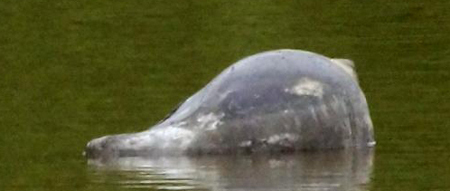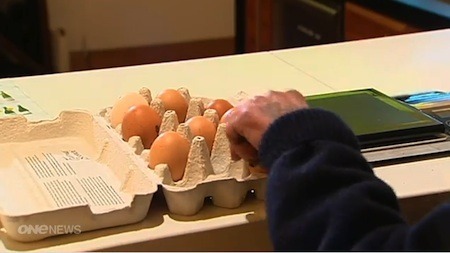Marc Abrahams's Blog, page 482
June 28, 2013
A wokfull of cockroaches – observing observers
The facial analysis system behind the recently featured ‘Laughing Mirror‘was developed by the Dutch firm VicarVision [* see note below] A description of their system, called ‘FaceReader ™ ‘ was published in Proceedings of Measuring Behavior, 2005 (Wageningen, 30 August – 2 September 2005) ‘The FaceReader: Online facial expression recognition‘ Since then the computer code has evolved considerably, and is now available in version 5.0. Their software distributor, Noldus, provide a video of the system in use:
“Here, you see participant six looking at a cook preparing dinner – in this case cockroaches.”
The paper explains the functions of faces ;
“Apart from being the means to identify other members of the species, the human face provides a number of signals essential for interpersonal communication in our social life. The face houses the speech production apparatus and is used to regulate the conversation by gazing or nodding, and to interpret what has been said by lip reading. It is our direct and naturally pre-eminent means of communicating and understanding somebody’s affective state and intentions on the basis of the shown facial expression.”
VicarVision also provide an on-line demo of their software that will analyse any (suitable) face photo – which can either be uploaded, or linked-to directly from a www url. Improbable tried this picture - and, after analysis, the system informed that the subject was :
gender : female
age : 55 – 65
with the attributes :
beard : none
moustache : none
glasses : yes
and displaying the expressions :
rather sad
somewhat disgusted
Try out your picture here: [see note 1 below]
NOTES:
[1] Unfortunately, shortly after our trial (late May 2013), the online software system appeared to stop working.
[2] * The ‘Vicar’ part of VicarVision is inspired by the word ‘vicarious‘ rather than ‘vicar‘.

June 27, 2013
Cherrie Thompson joins Luxuriant Flowing Hair Club for Scientists (LFHCfS)
Cherrie Thompson has joined the Luxuriant Flowing Hair Club for Scientists (LFHCfS). She says:
I am a PhD student working on G-protein signalling. Although G-proteins are present in hair cells, my research is not in the area of hair biology.
Cherrie Thompson, MSc, DIC, BSc (Hons), BEd, LFHCfS
PhD. student
King’s College London
Guy’s Hospital
London, UK


A dead dolphin, or dog

 June 25th 2013, zoologists in The Netherlands were alerted by a report of a dead bottle-nosed dolphin (Tursiops truncatus) washed ashore in an inland estuary just south of Rotterdam. This dolphin is a very rare species in The Netherlands, even in the nearby open sea. Photographs, posted on www.waarneming.nl (now removed, but reproduced here), indeed show a dead mammal-like creature. But was it a dolphin? Experts later concluded it was to small to be Tursiops truncatus and identified it as a harbour porpoise (Phocoena phocoena), still a rare find in inland waters.
June 25th 2013, zoologists in The Netherlands were alerted by a report of a dead bottle-nosed dolphin (Tursiops truncatus) washed ashore in an inland estuary just south of Rotterdam. This dolphin is a very rare species in The Netherlands, even in the nearby open sea. Photographs, posted on www.waarneming.nl (now removed, but reproduced here), indeed show a dead mammal-like creature. But was it a dolphin? Experts later concluded it was to small to be Tursiops truncatus and identified it as a harbour porpoise (Phocoena phocoena), still a rare find in inland waters.
Staff members of the Natural History Museum Rotterdam could not relocate the mammal and considered it ‘lost for science’.
The next day, locals found the cadaver [pictured below] and (probably) correctly identified it as a dead dog.
Thanks to Jo Polak, for reporting the dead dolphin, and later identifying it as a dog. Also thanks to www.waarneming.nl for updating the identification into ‘unknown mammal‘ because (dead) dogs can not be entered into their database.
BONUS: Kompanje, E.J.O. (2001) – Review of strandings and catches of Tursiops truncatus (Mammalia: Cetacea, Odontoceti) in the Netherlands between 1754 and 2000 – Deinsea 8: 169-224

June 26, 2013
The origin of the Eiffel Tower and leaning to the left
Rolf Zwaan [pictured here], writing in his blog, explains how his (and colleagues’) Ig Nobel Prize-winning study, ”Leaning to the Left Makes the Eiffel Tower Seem Smaller: Posture-Modulated Estimation,” came about:
In a previous post I alluded to the fact that I had produced an amusing title a few years ago for an article that was published in Psychological Science (it was intended as a parody on the article titles in that journal). I also mentioned that that article won the Ig Nobel Prize for psychology last year. This prize is awarded for “research that first makes you laugh and then makes you think.”
I thought it might be interesting to describe the creative process behind this paper. I’ll start by saying that I was not a creative force behind the paper, so I’m describing it as a participant observer.
My favorite Beatles song is A Day in the Life.…

Counting on: Childbirth and Orgasm
Today’s implicit statistics lesson is contained in a new study:
“Childbirth climax: The revealing of obstetrical orgasm,” Thierry Postel, Sexologies, epub May 3, 2013. The author, in Blainville-sur-Mer, France, explains:
“Giving birth and feeling an orgasm is a seemingly improbable link. For most women, this notion is perceived as an inconceivable myth. This study, published in Sexologies, aimed to draw attention to cases of physical pleasure experience by mothers during obstetrical labour. Researchers surveyed midwives to gather data about their patients spanning their entire career. Results showed that the pleasure was declared by the mother in more than 0.3% of deliveries and typical signs were observed in many more that may not have had the confidence to declare the experience….
“That said, considering the rarity and unpredictability of the phenomenon, the possibility of obstetrical pleasure cannot be generalized as an idealized representation of childbirth. It cannot, by any means, be used as a reason to sexualize childbirth with experiencing physical pleasure as a priority.”

The Laughing Mirror
 Are you one of those people who laughs every time you see yourself in a mirror? If you are (or even if you’re not) you may be interested in a project presented at the International Multimedia Conference, 2007. A Dutch research team assembled a computerised camera/display system which emulated a mirror – but with built-in facial and vocal recognition software driving the user feedback.
Are you one of those people who laughs every time you see yourself in a mirror? If you are (or even if you’re not) you may be interested in a project presented at the International Multimedia Conference, 2007. A Dutch research team assembled a computerised camera/display system which emulated a mirror – but with built-in facial and vocal recognition software driving the user feedback.
“The intention of the mirror is to evoke positive emotions, to make people laugh and to increase the laughter.”
“After a session with the mirror, which generally takes a couple of minutes, the users receives a score card with their laughter statistics and a verbal description, accompanied with their picture.”
“The Affective Mirror tracks user’s emotional states, determines the desirability of this state, and supports the occurrence of desirable emotions. In this way, an affective human-machine interaction was realized, comprising reciprocal human-machine perceive-act cycles via intuitive, visual and auditory, dialogues. As mentioned in the introduction, we do not know other applications that encompass this complete cycle in the real world.“
The full paper can be viewed here : ‘Affective multimodal mirror: sensing and eliciting laughter’

June 25, 2013
Official word: The body of Christ is not and cannot be gluten-free
If you are Catholic, what if you are allergic to the body of Christ? The answer may be hard to swallow.
Monsignor Mark J. Merdian [pictured here] takes a stab at solving the problem. His analysis appears in the magazine Homiletic and Pastoral Review:
Celiac Disease and Holy Communion: A Medical and Spiritual Dilemma
In this article, I hope to inform as many people as possible … about the damaging spiritual and physical effects of celiac disease. And … provide resources and pastoral recommendations for caring for individuals who may be unable to receive the Holy Eucharist in the sacred host because of this disease
The first time I had to deal with the issue of celiac disease, I was the pastor of a large suburban parish when the parochial vicar came into my office and asked if we had any Communion options for those suffering from celiac disease. He asked if we provided the precious blood to them or offered them some other spiritual remedy. Sadly, I responded in the negative….
[A letter from the] the Congregation for the Doctrine of the Faith (CDF) of the Vatican [specifies]:
Hosts that are completely gluten-free are invalid matter for the celebration of the Eucharist….
His is not the only word. Here are others:
“Celiac Disease and Eucharistic Communion,” Anne Bamberg, Jurist 61 (2001): 281.
“Coeliacs, alcoholics, the eucharist and the priesthood,” Aidan McGrath, Irish Theological Quarterly 67, no. 2 (2002): 125-144.
(Thanks to Miss Conduct for bringing this to our attention.)
BONUS: Tom Lehrer’s view (in 1967, approximately) of the bureaucracy that, ultimately, decides such questions:

Egging the world on
A self-authenticated report from a Yealand Estate, a farm in New Zealand, indicate that playing classical music induces hens to lay larger eggs:
LARGER EGGS FROM PLAYING CLASSICAL MUSIC TO OUR CHOOKS
Wayne, our resident bird expert & mechanic at Yealands, has been measuring eggs taken from chooks from our vineyard block where we play classical music to the vines, as well as from our other vineyard blocks (not exposed to classical music). The eggs from our classical music block are 19% bigger than eggs taken from elsewhere in our vineyard.
The claim is further authenticated by on a local television station. TVNZ presents details:
This at first glance is not fully in harmony with a Spanish study that found particular classical music seemed to induce fear in hens:
“Effects of specific noise and music stimuli on stress and fear levels of laying hens of several breeds,” J.L. Campo, M. G. Gil, and S. G. Davila, Applied Animal Behaviour Science, 91, no. 1 (2005): 75-84. The authors report:
“The treated group consisted of 54 hens (27 hens of each breed, in three replicates of nine hens) exposed to the specific sound stimulus of a 60 min tape with classical music (Mozart’s String Quartettes K 428 and K 458) between 9.00 and 14.00 for three days; the sound level was 75 dB maximum (ranging from 70 to 75 dB; background noises plus music)… a significant negative influence of noise (90 dB versus 65 dB) on the stressfulness and fearfulness of hens was reported, whereas the classical music (75 versus 65 dB) did not affect the level of stress of hens and had an increasing effect on their fearfulness.”
(Thanks to investigator Maria Eliseeva for bringing this to our attention.)


June 24, 2013
On Vulgar Numbers
David Justice wrote a little essay about vulgar numbers, or at least about things related to vulgar numbers:
we took to abstraction like — like a duck to water, like a kitteh to cheezeburger, like Donald Trump to a pile of manure. It was to some extent an end in itself… No sooner did we learn about a thing, than we wanted to generalize it. Actual numbers had been replaced by x and y in junior-high algebra; now we rushed to embrace the abstract structures in which these variables lived: groups, rings, fields … The brighter among us (I was not of their number) before graduation came to embrace what its own practitioners called “abstract nonsense” (category theory, “diagram-chasing”), the night in which all structures are grey.


Magazine: the special Boring Machines issue
 The special Boring Machines issue (vol. 19, no. 3) of the magazine (the Annals of Improbable Research) is now out!
The special Boring Machines issue (vol. 19, no. 3) of the magazine (the Annals of Improbable Research) is now out!
Articles include “Boring Machines“, “A Simple and Convenient Synthesis of Pseudoephedrine From N-Methylamphetamine“, and more, more, more, including new helpings of “Improbable Research Review”, “Boys Will Be Boys”, “Soft Is Hard”, and other outstandingly improbable research snippets from many fields and countries.
Mel (right) says it’s swell.
Click on the Mel’s face to see the table of contents, buy the e-book version (first download a free preview of it, if you like!), or subscribe to the paper version.

Marc Abrahams's Blog
- Marc Abrahams's profile
- 14 followers





